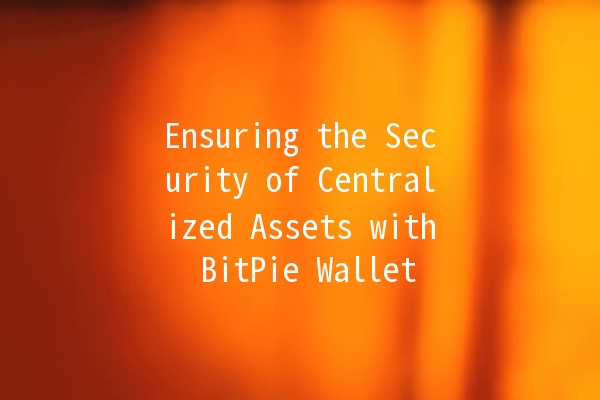
In recent years, the evolution of digital currencies has transformed the way individuals and organizations manage their financial assets. Among the multitude of wallets available in the market, BitPie has emerged as a popular choice due to its userfriendly interface and robust security features. This article seeks to explore how BitPie Wallet ensures the safety of centralized assets, providing actionable tips and insights for users looking to protect their investments.
Understanding the Importance of Asset Security
As the cryptocurrency market continues to grow, so does the importance of securing digital assets. Unlike traditional banking systems, cryptocurrencies operate on decentralized networks, which can make them susceptible to various risks, including hacks, frauds, and loss of private keys. Therefore, understanding how to securely manage these assets is critical for every user.
Key Risks Associated with Centralized Assets

How BitPie Wallet Addresses Security Concerns
BitPie Wallet has implemented several features designed to ensure the safety of centralized and decentralized assets. Below are five specific techniques that contribute to the security of users' digital investments:
Explanation: Multisignature technology requires multiple private keys to authorize a transaction. This ensures that no single user can unilaterally access the funds.
Application: Users can set up their wallets to require multiple confirmations when moving funds. For instance, if two out of three keys are needed to authorize transactions, even if one key is compromised, hackers cannot access the assets without the other keys.
Explanation: BitPie Wallet incorporates biometric authentication, which adds an additional layer of security beyond traditional passwords.
Application: Users can enable fingerprint or facial recognition to access their wallets. This makes unauthorized access significantly more challenging, as biometric data is unique to each individual and cannot be easily replicated.
Explanation: Conducting regular security audits helps identify vulnerabilities within the wallet’s infrastructure and allows for timely updates to enhance security.
Application: BitPie collaborates with thirdparty cybersecurity firms to conduct regular penetration testing and audits. This proactive approach ensures that any potential weaknesses are detected and rectified before they can be exploited.
Explanation: BitPie Wallet encrypts user data, ensuring that sensitive information, such as private keys and transaction history, is stored securely.
Application: All data is protected using advanced encryption algorithms, making it extremely difficult for attackers to retrieve private information even if they gain unauthorized access to the storage servers.
Explanation: Twofactor authentication adds an additional verification step when logging into the wallet or executing transactions.
Application: Users are required to provide a second form of identification—such as a onetime code sent to their mobile device—alongside their password. This significantly reduces the risk of unauthorized access.
Best Practices for Users
While BitPie Wallet offers several builtin security measures, users must also take proactive steps to safeguard their assets. Here are some effective practices:
Explanation: A strong password is composed of a mix of letters, numbers, and special characters.
Application: Instead of using easily guessable passwords, opt for a password manager to generate and store complex passwords.
Explanation: Enabling twofactor authentication offers an additional layer of protection for your account.
Application: Make sure to activate 2FA within the BitPie Wallet settings and use an authenticator app for optimal security.
Explanation: Phishing scams often mimic legitimate services to lure users into revealing sensitive information.
Application: Always verify the URLs of websites before entering your wallet credentials and avoid clicking on suspicious email links.
Explanation: Regularly backing up your wallet ensures that you have a recovery option in case of data loss.
Application: Create a secure copy of your wallet's seed phrase and store it in a safe place, like a hardware wallet or a secure offline storage solution.
Explanation: Keeping your wallet software updated helps protect against newly discovered vulnerabilities.
Application: Regularly check for updates from BitPie and install them promptly to ensure that you’re using the latest security features.
Frequently Asked Questions
BitPie Wallet is a digital wallet designed for storing, managing, and transacting cryptocurrencies. Compared to other wallets, BitPie offers unique features such as multisignature security, biometric authentication, and an intuitive interface designed for both beginners and experienced users.
Yes, BitPie Wallet implements several security measures, including encryption, multisignature technology, and regular security audits, making it one of the safer options on the market. However, users must also follow best practices to enhance their own security.
If you lose access to your BitPie Wallet, recovery is typically possible by using the seed phrase provided during wallet setup. It’s crucial to keep this seed phrase secure; anyone with access can recover the wallet.
Yes, BitPie Wallet is designed to support both centralized assets, such as fiat currencies, and decentralized assets, including various cryptocurrencies. This flexibility makes it a versatile choice for crypto investors.
If you receive a suspicious email or notification regarding your BitPie Wallet, do not click on any links or provide any personal information. Instead, report the incident to BitPie’s support team for guidance.
It is advisable to check for updates to your wallet software regularly. At least once a month, you should verify that you are using the latest version, as updates often contain important security patches and new features.
By utilizing BitPie Wallet’s robust security features and adhering to best practices, users can significantly enhance the safety of their centralized assets. The integration of innovative technologies and a focus on user education ensures that individuals can confidently interact with the cryptocurrency market while minimizing risks.

